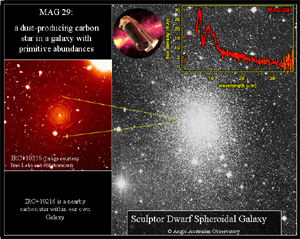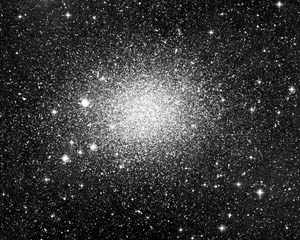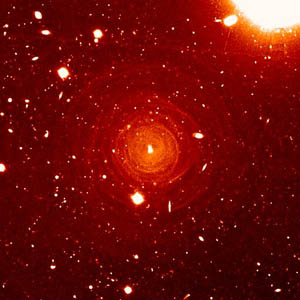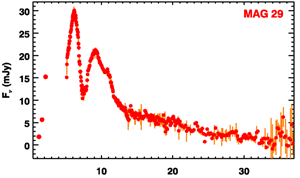Astronomers find dust around a primitive star, shedding new light on universe's origins
15th Jan 2009
Multi-Media Resources
Below: Montage showing an optical image of the nearby Sculptor Dwarf galaxy (courtesy David Malin, Anglo Australian Observatory) with the location of the carbon star MAG 29 indicated by a view of IRC+10216, a carbon star in our own galaxy (courtesy Izan Leao from Leao et al 2006, A&A 455, 187). The Spitzer spectrum of MAG 29 is overlaid on the Sculptor image along with a view of the Spitzer spacecraft itself.

Hi-res image
CREDIT: Eric Lagadec (University of Manchester, UK), Izan Leao (Universidade Federal do Rio Grande do Norte, Brazil), David Malin (Anglo-Australian Observatory).
Below: UK Schmidt Telescope optical image of the Sculptor dwarf spheroidal galaxy.

Hi-res image
CREDIT: David Malin, Anglo-Australian Observatory.
Below: Optical image of the carbon star IRC+10216 in our own Milky Way galaxy taken with FORS1 on the Very Large Telescope.

Hi-res image
CREDIT: Izan Leao (Universidade Federal do Rio Grande do Norte, Brazil).
Below: Infrared spectrum of MAG 29 taken with the Infrared Spectrograph on board the Spitzer Space Telescope showing features due to SiC and C2H2.

Hi-res image
CREDIT: Gregory C. Sloan (Cornell University), NASA.
An international team of astronomers has observed dust forming around a dying star in a nearby galaxy, giving them a glimpse into the early universe and enlivening a debate about the origins of all cosmic dust.
The findings are reported in the Jan. 16 issue of the journal Science (Vol. 323 No. 5912). The team included Greg Sloan of Cornell University, Mikako Matsuura of the National University of Japan, team leader Albert Zijlstra and Eric Lagadec of The University of Manchester's Jodrell Bank Centre for Astrophysics. The study was based on observations with NASA's Spitzer Space Telescope.
"Dust plays a key role in the evolution of galaxies such as our Milky Way, and is the building block for the formation of planets-and ultimately, life" says Lagadec.
Stars produce dust - smoke-like particles rich with carbon or oxygen - as they die. But less is known about how and what kind of dust was created in the first galaxies as they formed soon after the Big Bang.
"All the elements heavier than helium were made after the Big Bang in successive generations of stars", explained Zijlstra. "We came up with the idea of looking at nearby galaxies poor in heavier elements to get a close-up view of how stars live and die in conditions similar to those in the early universe."
The team discovered dust forming around the carbon star MAG 29, located 280,000 light years away in a small nearby galaxy called the Sculptor Dwarf. Stars more massive than the Sun end their lives as carbon stars. In our galaxy, carbon stars are a rich source of dust.
The Sculptor Dwarf contains only 4 percent of the carbon and other heavy elements in our own galaxy, making it similar to primitive galaxies seen at the edge of the universe. Those galaxies emitted the light that we now see soon after they and the universe formed.
"We haven't seen carbon-rich dust in this primitive an environment before," Sloan said. "What this tells us is that carbon stars could have been pumping out dust soon after the first galaxies were born".
Scientists have debated where the dust in the early universe comes from. Supernova explosions of massive stars have been a favourite suspect, but they may destroy more dust than they create.
"While everyone is focused on the questions of how much and what kind of dust supernovae make, they may not have appreciated that carbon stars can make at least some of the dust we are seeing," Sloan said. "The more we can understand the quantity and composition of the dust, the better we can understand how stars and galaxies evolve, both in the early universe and right next door."
"Observing stars such as MAG 29 is not unlike using a time machine", Sloan said, "in which astronomers can catch glimpses of what the universe looked like billions of years ago."
"MAG 29 is exceptionally rich in hydrocarbons, vital components in the chemistry that eventually led to the appearance of life on earth" added Mikako Matsuura from the National University of Japan.
It is part of a project led by Albert Zijlstra at the University of Manchester's Jodrell Bank Centre for Astrophysics and including other scientists in the USA, UK, Belgium and Australia.
Contacts
Albert Zijlstra,
Jodrell Bank Centre for Astrophysics
The University of Manchester
albert.zijlstra "at" manchester.ac.uk
+44 (0)161 306 3925
Eric Lagadec
Jodrell Bank Centre for Astrophysics
The University of Manchester
eric.lagadec "at"manchester.ac.uk
+44 (0)161 275 4145
Gregory C. Sloan
Cornell University, USA
sloan "at" isc.astro.cornell.edu
Source
Dust Formation in a Galaxy with Primitive Abundances
G.C. Sloan 1, M. Matsuura 2,3, A.A. Zijlstra 4, E. Lagadec 4, M.A.T. Groenewegen 5, P.R. Wood 6, C. Szyszka 4, J. Bernard-Salas 1, J. Th. van Loon 7
Science, Vol. 323, No. 5912, published 16th Jan 2009.
1Department of Astronomy, Cornell University, Ithaca, NY, USA
2National Optical Astronomical Observatory of Japan, Tokyo
3Department of Physics & Astronomy, University College London, UK
4School of Physics and Astronomy, University of Manchester, UK
5Royal Observatory of Belgium, Brussels, Belgium
6Research School of Astronomy and Astrophysics, Australian National University
7Astrophysics Group, Lennard-Jones Laboratories, Keele University, UK


